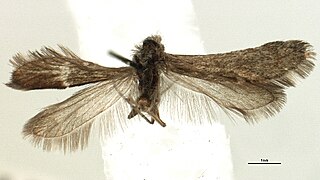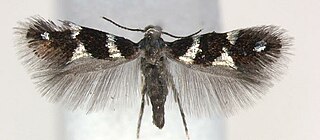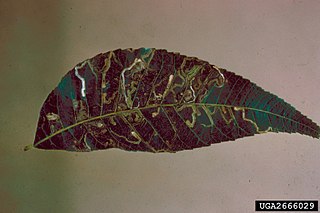
Heterobathmia is a genus of Lepidoptera. It is the only genus in the suborder Heterobathmiina, as well as in the superfamily Heterobathmioidea and in the family Heterobathmiidae. Primitive, day-flying, metallic moths confined to southern South America, the adults eat the pollen of Nothofagus or southern beech and the larvae mine the leaves. Most known species are undescribed.

Gracillariidae is an important family of insects in the order Lepidoptera and the principal family of leaf miners that includes several economic, horticultural or recently invasive pest species such as the horse-chestnut leaf miner, Cameraria ohridella.

Nepticulidae is a family of very small moths with a worldwide distribution. They are characterised by eyecaps over the eyes. These pigmy moths or midget moths, as they are commonly known, include the smallest of all living moths, with a wingspan that can be as little as 3 mm in the case of the European pigmy sorrel moth, but more usually 3.5–10 mm. The wings of adult moths are narrow and lanceolate, sometimes with metallic markings, and with the venation very simplified compared to most other moths.

The Heliozelidae, commonly known as shield-bearer moths, are a family of small, day flying monotrysian moths distributed worldwide. The larvae of most heliozelid species are leaf miners who cut distinctive shield-shaped cases from the surface of the host leaf, hence the common name. Some species are considered pests of commercial crops such as grapevines, cranberries, and walnuts. The taxonomy of this family is poorly understood.

The pecan serpentine leafminer is a moth of the family Nepticulidae. It is found in Ohio, Pennsylvania and Kentucky in the United States.
Coptodisca arbutiella, the madrone shield bearer, is a moth of the family Heliozelidae. It was described by August Busck in 1904. It is found in western North America from California to British Columbia.
Coptodisca cercocarpella, the curl-leaf mountain mahogany leafminer, is a moth of the family Heliozelidae. It was described by Annette Frances Braun in 1925. It is found in North America, including Arizona, California, Utah and Colorado.
Coptodisca ella is a moth of the family Heliozelidae. It was described by Vactor Tousey Chambers in 1871. It is found in North America, including Tennessee.
Coptodisca saliciella is a moth of the family Heliozelidae. It was described by Clements in 1861. It is found in North America, including California and Ohio.
Coptodisca juglandella is a moth of the family Heliozelidae. It was described by Vactor Tousey Chambers in 1874. It is found in North America, including California, Ohio and Illinois.
Coptodisca kalmiella is a moth of the family Heliozelidae. It was described by Dietz in 1921. It is found in North America, including New Jersey.
Coptodisca magnella is a moth of the family Heliozelidae. It was described by Annette Frances Braun in 1916. It is found in North America, including Kentucky, Mississippi and Ohio.
Coptodisca negligens is a moth of the Lepidopteria family. It was described by Annette Frances Braun in 1920. It is found in North America, including Ohio.
Coptodisca ostryaefoliella is a moth of the family Heliozelidae. It was described by James Brackenridge Clemens in 1861. It is found in North America, including Ohio.
Coptodisca powellella is a moth of the family Heliozelidae. It was described by Opler in 1971. It is found in California.
Coptodisca quercicolella is a moth of the family Heliozelidae. It was described by Annette Frances Braun in 1927. It is found in North America including California and Colorado.
Coptodisca rhizophorae is a moth of the family Heliozelidae. It was described by Walsingham in 1897. It is found in the West Indies.
Coptodisca ribesella is a moth of the family Heliozelidae. It was described by Annette Frances Braun in 1925. It is found in the US state of California.
Coptodisca splendoriferella, the resplendent shield bearer, is a moth of the family Heliozelidae. It was described by James Brackenridge Clemens in 1860. It is found in North America, including California, Ohio and South Carolina.





